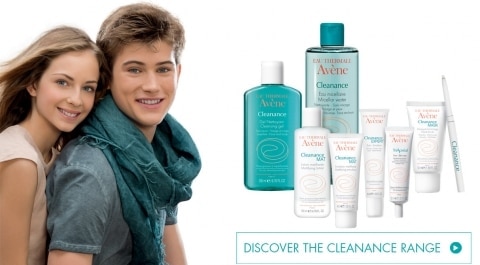What is Acne?
Acne not only affects the majority of adolescents, but also a significant proportion of adults. It is both incredibly common and highly visible due TO the fact that it affects the face, which makes it a real dermatological issue.
A condition affecting adolescents... and adults
Acne is synonymous with puberty, and affects approximately 80% of adolescents, with varying degrees of severity. However, patients do not often consult their doctor, let alone use an adapted treatment. This is surely due to their fatalistic attitude towards the condition; getting spots at the beginning of puberty is practically inevitable, the discomfort caused is not constant and the acne generally disappears on its own as adulthood approaches. However, although it is a common and temporary condition, acne is renowned for having significant psychological repercussions in adolescents, because it affects the face and directly interferes with the patient’s self-esteem and relationships with others.
Acne’s impact on self-esteem and confidence is also notable in adults. Its psychological effects are no doubt heightened by the fact that the subject has a 'teenager's condition'. Quite justifiably, they might have thought they had seen the last of their acne, or it may never have occurred to them that they might be affected as an adult. These cases of “late onset acne” are far from rare. When questioned as part of an American study in 2007, 73% of adults aged over 20 claimed they were affected by acne, with more women claiming they are affected than men in every age group up to 50 years. Although the results of this study should be cautiously interpreted, dermatologists agree that there is a high prevalence of adult acne, estimating that 4 out of 10 women have acne problems.
TargetED areaS: face, shoulders, neck, neckline
Acne is the most common reason for which patients seek advice from dermatologists. The trademark spots and lesions and their location on the body mean that diagnosis is generally very easy. In their official terminology, doctors refer to acne as “inflammatory dermatitis of the pilosebaceous follicles, with formation of comedones”. In fact, acne begins in the pores; under the skin the sebaceous glands secrete sebum, which flows on to the skin’s surface via the pilosebaceous canal. Problems begin when too much sebum is produced - the skin becomes oily and shiny. Some pores become blocked creating a plug, which traps the sebum, as well as dead skin cells and bacteria - ideal conditions to trigger inflammation. This causes unsightly and persistent spots to form, primarily on the face, neck, neckline, shoulders and even the back. In adults, acne usually affects the lower half of the face and is most commonly found around the jaw.
Despite its simple mechanism and temporary effects, acne should not be taken lightly, as it can often leave permanent marks. Large and persistent inflammatory lesions can have an impact on the skin's structure. This is the case in somem severe forms of acne, but also in inflammatory lesions that have been mishandled or not cared for properly. So since taking care of acne scars is difficult, prevention is better than cure.
Where does it come from?
Hormonal and genetic factors, diet, stress, hygiene, environmental causes? Dermatologists cannot pinpoint a single culprit, as all these factors can contribute to the appearance of acne, the persistence of spots, and the typical acne “flare-ups”.
However among this variety of potential causes, there are one or two which are more clearly responsible.
Hormonal factors
The excessive sensitivity of sebaceous glands to androgen hormones is undeniably how acne begins. It commonly appears during puberty, a period of significant hormonal changes in the body. (It is best to focus on hormonal disorders linked to puberty and hormonal fluctuations in women as an aggravating factor)
Genetic factors
Genes are a major element of acne; in nearly half of all adolescent cases (45%), one of the patient's parents was affected with acne. And among those who escape teenage acne, their parents had similar luck in 92% of cases. The same is true for adults: if an adult woman has acne, there is a family history of adult acne in 50% of cases. (The familial risk between first-degree relatives of affected and unaffected individuals. Br J Dermatology 1999; 141; 297-300).
TRIO OF FACTORS
Oily skin
In normal conditions, sebum helps to protect the skin from aggression and dehydration by forming a thin film of lipids on the surface. During puberty, a sudden increase in hormone levels boosts the activity of the sebaceous glands, almost as if these glands were too sensitive to androgen hormones. The skin becomes oily, and acne appears soon after.
The formation of comedones
An abnormal and excessive proliferation of cells on the skin's surface helps to block the pores, causing the appearance of open comedones (blackheads) and closed comedones (whiteheads or microcysts).
Inflammation
Ordinarily, Propionibacterium acnes bacteria live on the skin and in the hair follicles in both male and female adults and adolescents. They are completely harmless and even help to keep the skin in balance. However, excess sebum allows them to multiply into abnormal quantities, releasing substances that trigger inflammation in the blocked follicle, and causing the red spots that are typical of acne.
OTHER AGGRAVATING ELEMENTS
It seems that any hormonal change in women can exacerbate acne. Menstrual periods and oral contraceptives, may also contribute.
Sun exposure
Although acne may temporarily improve soon after exposure (due to a bactericidal effect of UV rays, and the fact that tanned skin hides acne lesions), the sun actually thickens the skin and thus aggravates acne.
And diet?
Studies conducted so far have not concluded a definite role for diet in acne flare-ups. “Chocolate, fries and pizza do not have any effect” insists the American Academy of Dermatology and their French peers agree that cured meats are not a factor either. Certainly, once acne treatment is being properly administered, diet does not cause any skin problems. However, the AAD recognizes that there are always variations on an individual level, and if people notice that certain foods are triggering their acne, they should definitely try to avoid them.

